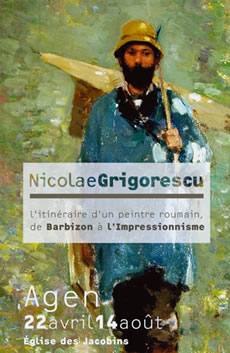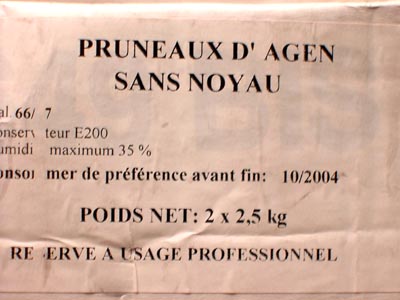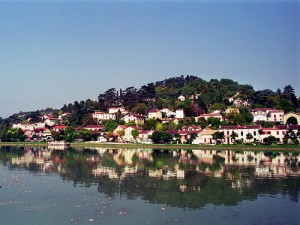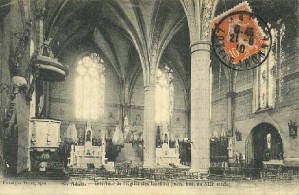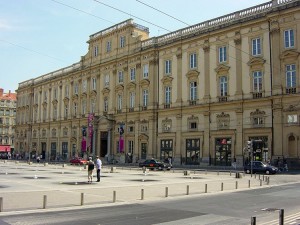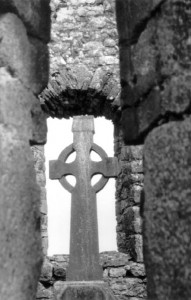MEDICAL CARE UNDER DICTATORSHIP
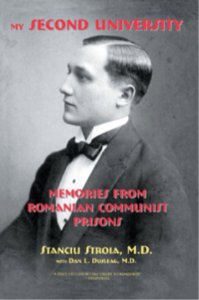
Dr. Stanciu Stroia: "My Second University"
(“My Second University” Two Reviews: Ionel TARANU and Constantin ROMAN)
“My Second University – memories from Romanian Communist prisons”
by Dr. Stanciu Stroia and Dr. Dan Dusleag,
(iUniverse Inc., New York, 2005, 271 pages,
Index, illustrations, £10.53 ISBN: 0-595-34639-1)
THREE GENERATIONS OF MEDICAL DOCTORS UNDER DICTATORSHIP:
Dr. Stanciu Stroia was born in rural Transylvania. He was a graduate of Cluj University Medical School, with a doctoral dissertation on the “Radiotherapy in Basedow desease”, submitted in 1928. As a junior doctor he moved over to the Regional Hospital of Fagaras where, in the early 1930’s he established the first department of Internal Medicine. By the age of 41 he became the director of that establishment. This was during WWII and only one year earlier the Soviet armies occupied Romania. With them, on the back of Russian tanks came the fifth columnists, the handful of exiled Romanian communists who were going to impose a new “social order” of Stalinist brand. At this point Dr. Stroia’s high-profile medical position, caused him to be invited to join the ranks of the Communist Party, which he refused. This stance marked him as an “undesirable” by the Communist hierarchy. Once Romania turned into a one-party dictatorship, in 1948, the medical know-how became subsidiary to political allegiance: this is how, in 1949, Dr. Stroia was demoted from his position of hospital director. Two years on he was under pressure to become an informer of the Securitate, the ubiquitous Romanian Secret services. This he rejected outright, because of his personal and professional ethics and so, in 1951, he was arrested for allegedly “helping and not denouncing anti-communist partisans”. He was given a six-years prison sentence on trumped up charges of “favoring the crime of plotting against the Romanian state”. Within 48 hours of his arrest, his wife and two young children were evicted from their private property, his estate was nationalized, the medical practice confiscated and the house eventually demolished. During his long prison years, he was not allowed to receive any correspondence or food and clothes parcels, except on one occasion. On his release, in December 1957, Dr. Stroia was made to sign a declaration undertaking not to disclose his prison experiences, under threat of being re-arrested. He was also forbidden to restart his medical practice in his home town and was relocated instead in a remote province. Nine years after his release and after many failed attempts Dr. Stroia was granted, in unusual circumstances, a “political and judicial rehabilitation”, for a crime he has never committed and which was in private, but never officially acknowledged, of having been a “misguided interpretation of the law”. He retired at the age of 64, when Ceausescu just came to power and thereafter he spent all summers in his native village in Transylvania, where he offered free medical consultations.
The second author is Dr.Dan Liviu Dusleag, the grandson of Dr. Stroia. who, like his grandfather, four decades earlier, he refused to join the Communist Party. Also like his grandfather, a year later, he also rejected the offer of becoming a Securitate informer. These were the darkest years of Ceausescu’s surreal dictatorship and as one could see, some forty years on, how the old Communist practice remained unchanged. As a consequence of his refusal Dan Dusleag was denied a passport to travel abroad. By this time, as a student of Bucharest Medical School, Dusleag participated in the Romanian Revolution of December 1989, and in the mass demonstration and sit-in of the Bucharest University Square in the summer of 1990. These were pivotal political events, which ended in mass murders and carnage. In December 1989 students of Timisoara and Bucharest Universities were shot by unknown snipers and their bodies disappeared. After Ceausescu’s downfall, the student demonstrators of June 1990 were somewhat luckier, as few of them were killed: but many were instead severely beaten up and injured, by an angry mob of miners called upon by the neo-communist Romanian president to “restore order” (communist order that is). Unsurprisingly, there was never a will by the Romanian Government to punish those responsible for such atrocities.
Dr. Dusleag’s hopes of Romania ever becoming a free country were shattered, and in 1990 he decided to emigrate to the USA. He completed his training as a paediatrician at the University of Chicago Medical School and currently he is a Clinical Assistant Professor at the Indiana University School of Medicine.
There is a third contributor to this book: she is Lucia Dusleag, MD, now retired and living in Toronto: she is the daughter of Dr. Stroia, and the mother of Dr. Dan Dusleag. She transcribed and edited the Romanian version of her father’s memoirs and contributed the Epilogue of the book. Here one could discover some amazing details on the survival of a medical student who was herself the daughter of a political prisoner during the communist dictatorship in Romania: these were years of hunger, of deprivation and of fear of being “found out” and expelled from the Cluj University Medical School, for she was, as she describes “the offspring of a political convict with the right academic credentials, but the wrong social background”.
A UNIQUE MEDICAL TESTIMONY OF PRISON PRACTICE:
“My Second University” marks a distinct departure from the angle and content of other similar stories and there are several reasons, which sets it apart:
First one must point out Dr. Stroia’s dogged courage and determination to put pen to paper at a time when he was still under surveillance by the Securitate. He was conscious that he ran a permanent risk of having his house searched and if the manuscript came to light he would have received a new prison sentence. At his advanced age this will certainly have represented a death sentence.
Secondly Dr. Stroia’s manuscript eventually made its way to the West, where, owing to the love and dedication of his grandson, it was translated in English. Both daughter and grandson carefully edited and provided the footnotes and other background information such as extensive illustrations, bibliography and an Index.
Thirdly and most importantly this memoir has an unique quality, in offering an invaluable insight, from a doctor’s point a view (that is of a doctor-prisoner, who was at the receiving end, as an inmate in a political prison) of how medical care was operated behind bars, in Communist Romania and what were the clinical consequences of the prison’s regime on the detainees, how did the food rationing and the torture affected the physical and mental health of the people inside the penitentiaries.
We read in the chapter on the Consequences of Imprisonment (p. 182):
“As a result of my severe and prolonged scurvy, I must have lost fifty per cent of my nerve cells through irremediable atrophy, an insult from which I never recovered. Only a detailed post mortem pathological exam could demonstrate the extent of injuries sustained by a scurvy-affected brain. Many intellectuals I met in Aiud (prison), especially those experiencing generalised dystrophic symptoms, lost their short and long-term memory. Knowing that I was a physician, they would ask me if this loss was reversible. Of course I had to encourage them, even if they told me, for instance, that they could not remember the names of their own grandchildren.”
A FRESCO OF TRANSYLVANIAN SOCIETY:
But beyond these pages on Romanian prisons, “My second University” is also a Social History of the Romanian professional classes, with roots deep among the rural peasantry of Transylvania. In his family Dr. Stroia represented a first generation of University graduates. He was very proud of his origins and felt always close to the people who tilled the land and raised livestock.
Stroia was not politically engaged against the communist dictatorship and he should have had no reason to fear its wrath, except for the arbitrary repression that such regime meted on innocent people: he became one of its victims and spent six and a half years behind bars, from April 1951 to December 1957. These was the long trail of notorious prisons (Sibiu, Jilava, Aiud, Fagaras), the carcer isolation, the torture, the humiliations, the malnutrition and physical degradation – never the moral collapse, as Dr. Stroia’s kept his spine upright and never cowered.
It is not because one may have read about Solzhenytsyn’ gulags that these memoirs may be less poignant, quite the contrary. But the difference here lies in the tone of the narrative, which is neither strident nor bitter – it is instead quietly factual, almost clinical, as the medical eye surveys the human sufferings and frailties, as well as the medical effects, which the prison regime had on the human body. For this prisoner’s enquiring mind this experience became a learning curve, not so much his Golgotha, for he was far too dignified to present it as such, rather something, which he describes metaphorically as his “second university”.
“My second University” introduces into the narrative a broad variety of characters from the Transylvanian landscape, from humble herdsmen, village priests and minor country squierarchy, to Hungarian aristocrats, like Count Bethlen, brother of the Hungarian PM and Orthodox and Uniate Bishops, and Politicians and, inevitably, fellow members of the medical profession, but also prison warders and torturers, communist satraps, not forgetting the informers and Securitate spies of which there were many. In fact the whole gamut of post-war Romanian panorama is present here, unfolding before our eyes, for this is a very ‘Transylvanian’ book, not just for its contents, characters and situations it describes, but especially for the directness and forcefulness of its presentation.
MEDICAL PRACTICE AFTER PRISON RELEASE:
Once out of prison, as a “re-educated member of the society” (sic!) the news of Dr. Stroia’s release reached the countryside and a delegation of elders, came along begging him to be their village GP:
“ Over time, many area residents started to inquire about my whereabouts, even asking for medical assistance; they remembered the many successful years I spent at their service. Then one day in late March 1958 a group of peasants from the nearby villages of Visnea de Jos, Visnea de Sus, Feldioara and Ucea showed up at my door, led by a local mayor, with a petition signed by eight hundred of them. They requested my acceptance for employment in their clinic, recently vacated because of the death of the local doctor under dubious circumstances. The offer sounded very attractive as the area was located a mere twenty-five kilometers South of Fagaras”.
But for any assignment he would have had to obtain the approval of the secret police: in no time at all he was warned by a Securitate officer never to accept such invitation or else he might not be alive:
“Noticing my hesitation and aware of my popularity, he added an open-ended question:
<>
Taken by surprise, I answered cautiously <>.
A reply failed to follow. The expression on the man’s face was self-explanatory.
In all truth the officer did me a great favor, allowing me to avoid suspicious situations leading to more trouble. The incident served as a reminder of the document I signed upon my release from prison.”
Dr. Stroia was redirected instead to a remote region, where he had no previous family roots and where he had no previous contacts. Still he had to remain over-cautious:
“With my colleagues I maintained a strictly professional relationship. No social interaction or house visits ever took place. After all these were the directives I had received from the Securitate and had to comply with upon my release. Occasionally, as I was hearing about ex-political detainees being frivolously fired from their jobs, some well-meaning individuals were compelled to remind me: <> (“Be careful, Doc”).
But in spite of all the care he took Dr. Stroia could not please the all-powerful Communist Party hacks and Securitate stooges. One of them in particular, the First-Secretary of the District Communist Party, publicly labeled him a “cheat”, and a “bandit”, which was the classic jargon for an “enemy of the people’”, or rather for anybody who did not approve of the Communist practice. Ironically, such attitude was soon going to change when the First-Secretary’s only son, an 18-years old, was in a bad way, after a night’s drinking binge:
“The First-Secretary himself requested an appointment at his house, at the suggestion of other concerned local physicians. His 18-year old son had returned from high school graduation party, which included a lot of plum brandy consumption and had failed to wake up after twenty-four hours deep sleep. With an unconscious son, he was requesting the opinion of the <> (the old crook) asking for treatment and a fair prognosis. Aided by my knowledge of toxicology acquired during long night shifts at the University emergency room and following a thorough examination I reassured the First-Secretary that despite a lack of guarantees in Medicine, his son would wake up rather than suffer a post-comatose death. Forty-eight hours of toxic sleep later the young man returned to life.
From that moment on I became the ‘savior’ and the First-Secretary my biggest and most vociferous fan. My presence was acknowledged from a distance and he made sure to shake my hand and congratulate me over again on every social occasion. Shortly thereafter, on June 8, 1966 I obtained my final rehabilitation, as a result of the decision of the regional tribunal.
<> (He is now fully re-educated!), proclaimed the Judge. <>”.
Quite!
“My second University” should be of great interest to the medical and liberal professions in the West to help them realize the extent to which the fellow-medical colleagues in the East suffered under dictatorship. Moreover it is important as a sobering tale to see how lucky we were in the West for having missed such experience, because soon after WWII it might have taken very little for the same political practice to engulf the whole of Western Europe. Churchill knew that we missed this turning by a whisker.
The book is available online from Dr. Dan Dusleag
http://ddusleag.home.insightbb.com/wsb/html/view.cgi-home.html-.html
the publisher’ site
http://www.iuniverse.com/Bookstore/BookSearchResults.aspx?Search=my%20second%20university
and from Amazon:
http://www.amazon.com/My-Second-University-Memories-Communist/dp/0595346391/sr=8-1/qid=1160880699/ref=pd_bbs_sr_1/104-5773333-2987943?ie=UTF8
—————————————————-
“My Second University – memories from Romanian Communist prisons” by Dr. Stanciu Stroia and Dr. Dan Dusleag, Published by iUniverse Inc., New York, 2005, (paperback, 271 pages with Index and illustrations)
Post-Ceausescu Romania has produced a number of prison memoirs of people who wanted to speak and whose voices were stifled by the Communist regime. More often than not those few gulag survivors had the misfortune of not outliving their Communist captors and if by miracle some of them came out of prison, they lived instead in constant fear of being denounced and re-arrested – that seditious fear to which a Romanian-American author referred to, metaphorically as “people buried deep under a snowlike blanket of fear”.
Romania, which will eventually integrate the EU, is obviously looking ahead, rather than to its recent past, to the point that many think that one lives through a phase of pre-programmed amnesia, by ignoring the sufferings of previous generations, and of the cultural, professional, religious and political elites who perished in prisons to end up in unmarked graves.
There are, however, a few exceptions – survivors who lived to tell the story: they were not from the ranks of the aristocrats or intellectuals: most of these were not strong enough to survive their ordeal as their regime was harshest and most inhumane. Still, there were some survivors from the simple peasantry, like Elisabeta Rizea of Nucsoara (1912-2003), whose eloquence expressed in an unsophisticated vernacular convinced us beyond any doubt about the destructive effect which communism had on the whole of Romanian society. Rizea was not alone to voice these feelings if one thinks of scores of other people of her kind, who gave evidence in interviews taken after 1989: Lucretia Jurj, (1928-2004), Elena Arnautoiu, or Ion Gavrila Ogoranu took to the mountains to fight the communist terror. Sadly, their extraordinary accounts never came to the attention of any film director as they were never translated in a language of international circulation – the one exception are the Memoirs of Nicole Valéry-Grossu, published in French under the title “Bénie sois-tu prison”, which was made into a film, in 2003, by Nicolae Margineanu, under the title “Binecuvantata fii, inchisoare”, which got two prizes at the Montreal Fim Festival.
So, one may well ask, what if anything new did Dr. Stroia’s account bring to the literature of the Romanian communist gulags?
From the outset it is clear to any reader that “My Second University” marks a distinct departure from the angle and content of other similar stories and there are several reasons, which sets it apart.
Dr. Stanciu Stroia (1904-1987) died only a couple of years before Ceausescu was put down in Bucharest and the fact that his memoirs survived is due to unusual circumstances:
First one must point out the author’s dogged courage and determination to put pen to paper at a time when he was still under surveillance by the Securitate, the Romanian Secret Services. He was conscious that he ran a permanent risk of having his house searched and by writing about his prison ordeal if the manuscript came to light he would have received a new prison sentence. At his advanced age this will certainly have represented a death sentence.
Secondly Dr. Stroia’s manuscript eventually made its way to the West, where owing to the love and dedication of his grandson Dr. Dan Dusleag, a paediatrician of Indiana University School of Medicine, aided by his mother, Dr. Lucia Dusleag (née Stroia) of Toronto and author of the book’s Epilogue, “My second University” was translated in English. Both daughter and grandson carefully edited and provided the footnotes and other background information such as extensive illustrations, bibliography and an Index.
Those of the readers familiar with the process of writing and being published would understand that such effort would represent only the tip of the iceberg before finding a sympathetic publisher and seeing that the book reached a wider public through the right distribution, promotion and exposure in review articles. Here again the indefatigable grandson has done his job thoroughly seeing that some eminent scholars voiced their opinion about the book, which now has its own website:
http://ddusleag.home.insightbb.com/wsb/html/view.cgi-home.html-.html
From hence one could read the book’s media coverage, but also have an idea about the structure of the book, its main chapters, a selection of excerpts, thirty-six pages of photographs and a compilation of one thousand names of political detainees of the Fagaras prison.
Thirdly and most importantly this memoir has an unique value in offering an invaluable insight from a doctor’s point a view (that is of a doctor-prisoner, who was at the receiving end, as an inmate in a political prison) of how medical care was operated behind bars in Communist Romania and what were the clinical consequences of the prison’s regime on the detainees, how did the food rationing and the torture affected the physical and mental health of the people inside the penitentiaries.
But beyond these pages of Romanian prisons, “My second University” is a fresco of the Transylvanian society in transition from the dawn of the Habsburg empire to the Soviet occupation of Romania, after WWII. This was the point of entrenchment of the Communist system, which came there to stay for over 40 years, to 1989. The book spans over a period of some hundred and fifty years and seven generations. yet, in spite of it, and perhaps because of it this is not only a family history, it is also a Social History of the Romanian professional classes, with roots deep amongst the rural peasantry of Transylvania. These are the people who formed the backbone of “Greater Romania” (Romania Mare), which came into being after the demise of the Habsburg Empire, in 1919. The authors take us back to the first half of the19th century through the family history in a village of Cacova, near Sibiu, at the foot of the Carpathian Mountains, where the authors’ ancestors were farmers and priests or were raising their flock as shepherds. It is from this rural population that a new class of educated people was raised in modern Romania and Dr. Stroia represented a first generation with a University degree. He was very proud of his origins and felt always close to the people who tilled the land and raised livestock: odd as it may appear to be this was going to contribute to his downfall and imprisonment by the Communists, because of his popularity amongst the simple folk and all people who met him and worked with him in the hospital where he was a director. As a high-profile medical doctor Stroia was not politically engaged against the communist dictatorship and he should have had no reason to fear its wrath except by the arbitrary actions of repression that such regime meted on innocent people: he became one of its victims and spent seven years behind bars, from 1951 to 1958.
Followed the long trail of notorious prisons (Sibiu, Jilava, Aiud, Fagaras), the carcer isolation, the torture, the humiliations, the malnutrition and physical degradation – never the moral collapse, as Dr. Stroia’s kept his spine upright and never cowered.
It is not because we have read about such things before that these memoirs may be less poignant, quite the contrary. But the difference here lies in the tone of the narrative, which is neither strident nor bitter – it is instead quietly factual, almost clinical, as the medical eye surveys the human sufferings and frailties, as well as the medical effects, which the prison regime had on the human body. For this prisoner’s enquiring mind this experience became a learning curve, not so much his Golgotha, for he was far too dignified to present it as such, rather something, which he describes metaphorically as his second university. We read in the chapter on the Consequences of Imprisonment (p. 182):
“As a result of my severe and prolonged scurvy, I must have lost fifty per cent of my nerve cells through irremediable atrophy, an insult from which I never recovered. Only a detailed post mortem pathological exam could demonstrate the extent of injuries sustained by a scurvy-affected brain. Many intellectuals I met in Aiud (prison), especially those experiencing generalised dystrophic symptoms, lost their short and long-term memory. Knowing that I was a physician, they would ask me if this loss was reversible. Of course I had to encourage them, even if they told me, for instance, that they could not remember the names of their own grandchildren.”
Dr. Stroia’s stamina and moral rectitude helped him survive the seven years spent in some of Romania’s most infamous penitentiaries. He proved right one of his friends who exclaimed, whilst seeing him during a chance encounter after his release from prison:
“Nu mor caii cand vor cainii”.
(in literal translation – Horses never die when dogs want it – in this context – when hyenas want it)
He wrote his book for seven years, between 1979 and 1986, during a period of worst communist excesses under Ceausescu’s dictatorship and he finished it when he was 82 years of age. A year later he died and it took a further 18 years before his memoirs were published in the USA: this is proof of a family’s fortitude in the face of adversity. We must be grateful to them, for we become richer and wiser, as we experience a mixture of pride and humility when turning the pages of this book.
As one would expect “My second University” focuses on Dr. Stroia’s seven prison years from 1951 to 1958, under Gheorghiu-Dej, the Communist dictator installed by Stalin to rule with an iron fist. But this is not the whole story. As we mentioned before, the book unfolds in the broader context of the author’s medical career and life span from 1904 to 1987, (with an Epilogue written by his daughter and an introduction and Acknowledgements contributed by his grandson, Dr. Dan Dusleag which bring us to the present day). Beyond this, the memoir encompasses a more extensive period of ‘borrowed memory’ from the earlier direct ancestor – the greatgrandfather Stanciu Stroia of Zavoi, mayor of Cacova in the first half of the 19th c Transylvania. This social backdrop introduces into the narrative a broad variety of characters from the Transylvanian landscape, from humble herdsmen, village priests and minor country squierarchy, to Hungarian aristocrats, like Count Bethlen, brother of the Hungarian PM and Orthodox and Uniate Bishops, and Politicians and inevitably prison warders and torturers, communist satraps, not forgetting the informers and Securitate spies of which there were many. In fact the whole gamut of post-war Romanian panorama is present here, unfolding before our eyes, for this is a very ‘Transylvanian’ book, not just for its contents, characters and situations it describes, but especially for the directness and forcefulness of its presentation. For Stanciu Stroia has very precise views which stem from an early upbringing in the care of a young widowed mother, belonging to ‘Old Transylvania’. Indeed, Dr. Stroia is himself a representative of Old Transylvania, who, half way through his medical career is imprisoned and once freed, seven years later, he has to pick up his fractured existence and adapt, the best he can within the constraints of communist dictatorship, which keeps him on his guard. Still he remains a free spirit to let us know what he thinks.
It is a real blessing to have such book made available to an Anglo-Saxon readership, as accounts of Romanian Communist prisons are very little documented in English (a few titles that come to mind are Annie Samuelli’s “Woman Behind Bars in Romania”, (Frank Cass, 1997), Pastor Wurmbrand’s “If prisons wall could speak”, 1993 and “Tortured for Christ”, 1998, Anita Nandris-Cudla’s “Twenty Years in Siberia”, 1998 and Lena Constante’s “The Silent Escape: Three Thousand Days in Romanian Prisons”, University of California Press, 1995).
“My second University” should be read by everybody young and old, and certainly by the medical and liberal professions in the West to help them realize the extent to which its fellow-medical colleagues in the East suffered under Communist dictatorship: it might have taken very little for the same political practice to engulf the whole of Europe, soon after WWII. Dr. Stroia’s book makes one aware of how very fortunate we were in the West for having missed such an experience.
Constantin ROMAN (London)
——————————————————————————————
Read more about Romanian Political Prisoners in:
Blouse Roumaine – The Unsung Voices of Romanian Women
(Centre for Romanian Studies, London, 2009)
(1,100 pages, 160 Biographies, 600 quotations)
http://www.blouseroumaine.com/buy-the-book/index.html


